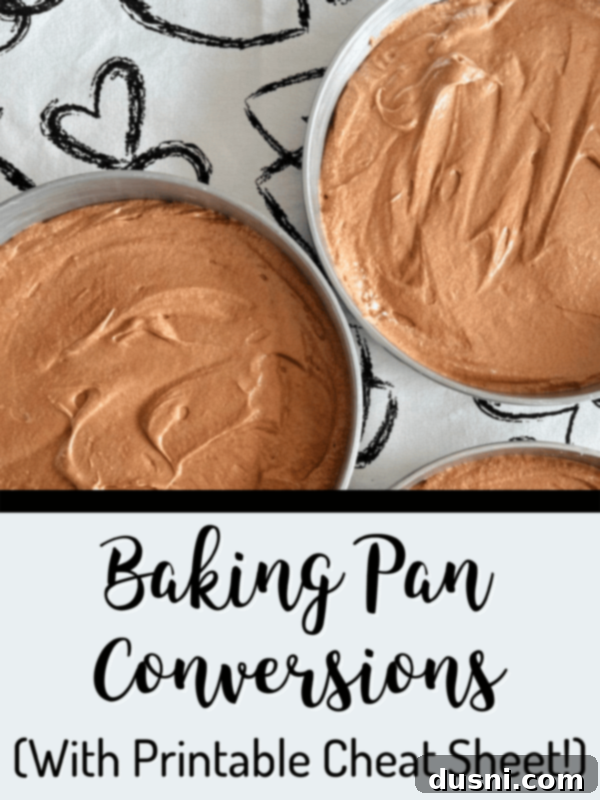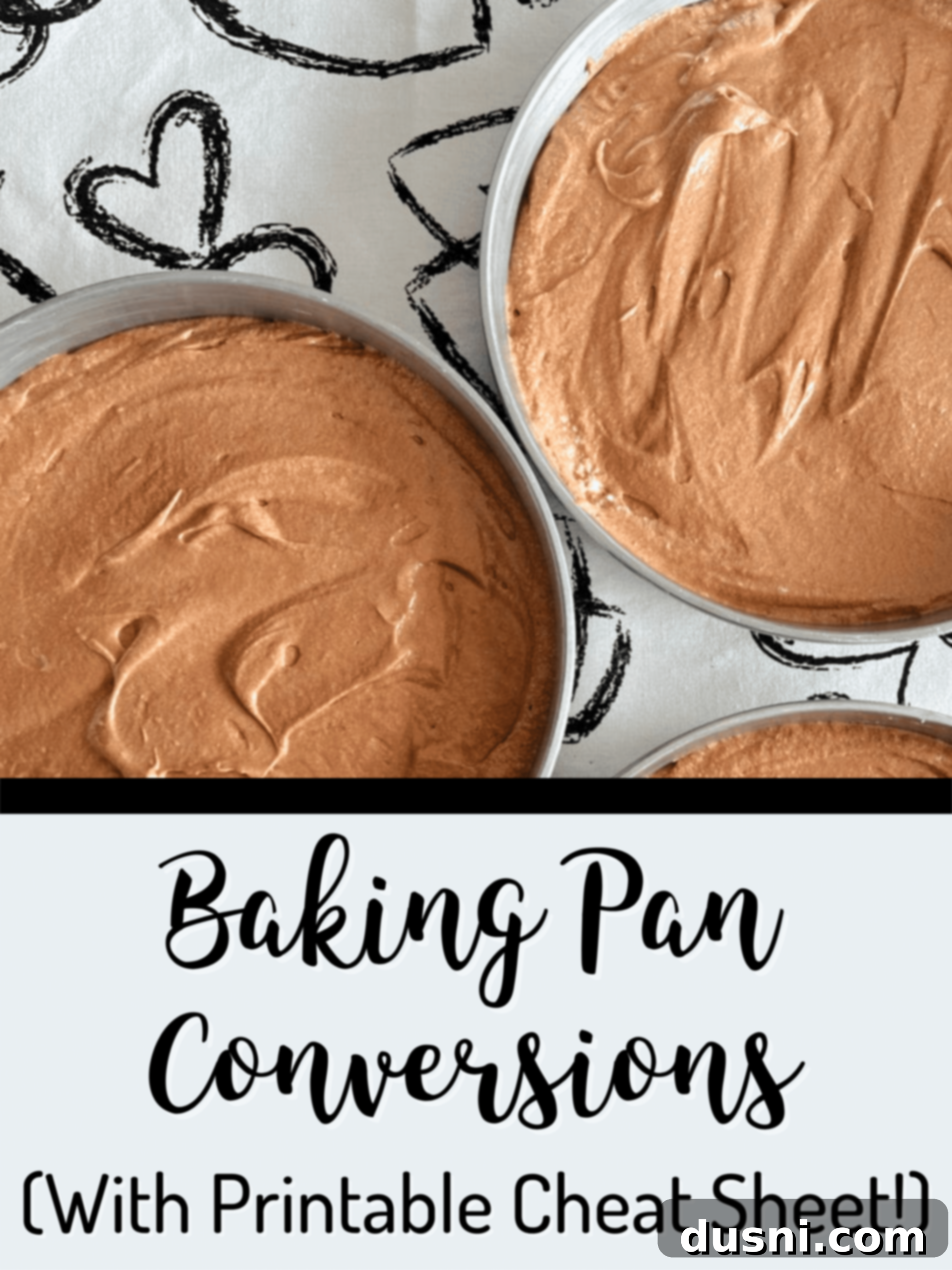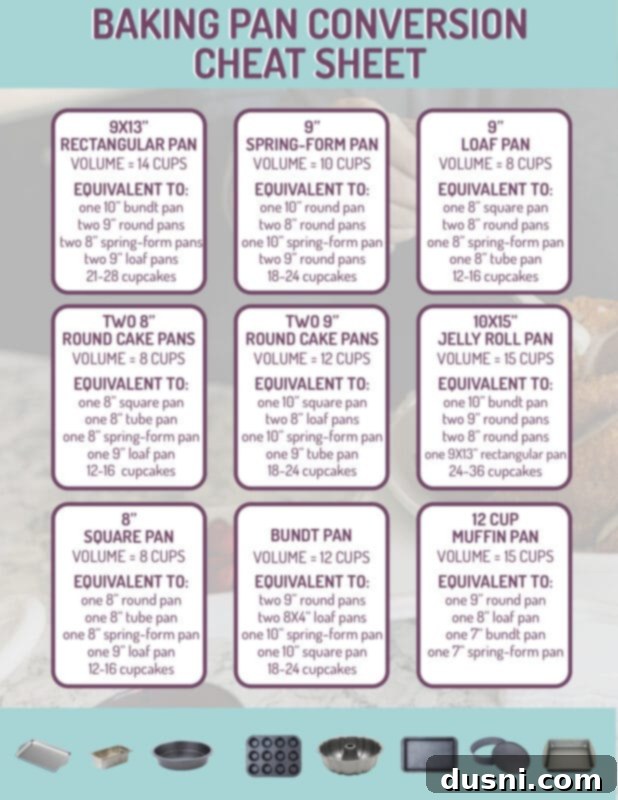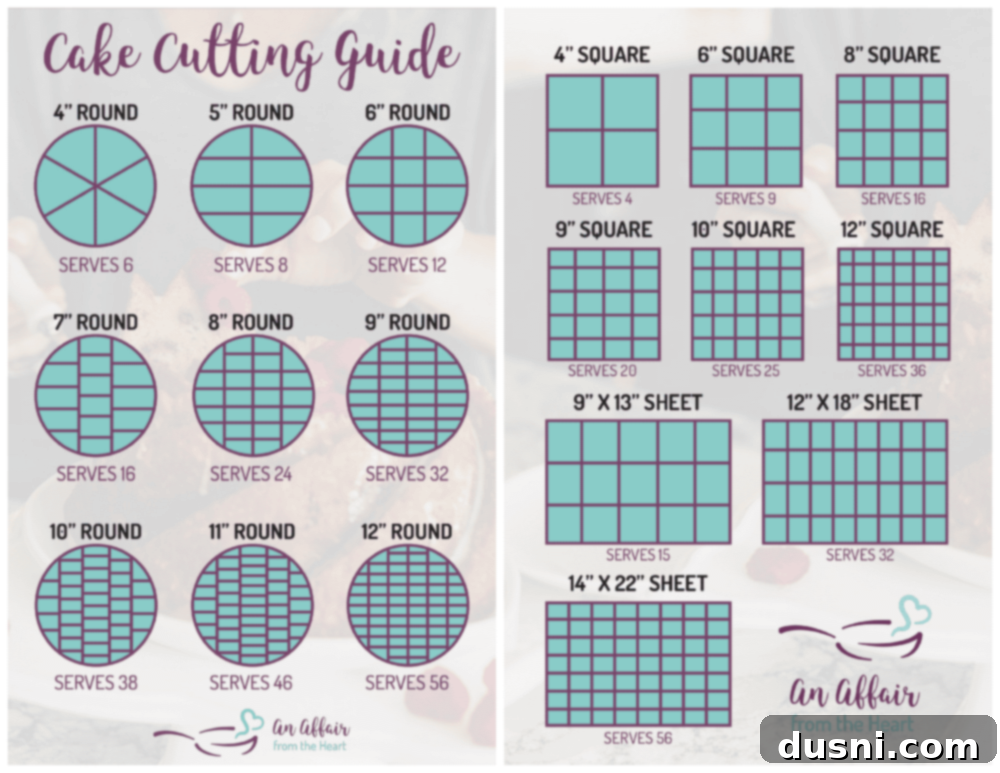Ultimate Baking Pan Conversion Guide: Master Your Cake Pan Sizes and Substitutions for Perfect Bakes
We’ve all been there: halfway through mixing a recipe, you realize you don’t have the exact baking pan size the recipe calls for. You might quickly grab a 9″ x 9″ pan when the recipe clearly stated 9″ x 13″, or vice versa. This seemingly small decision can make a monumental difference in the outcome of your baked goods. When it comes to baking, precision is key, and pan size profoundly impacts everything from baking time to the final texture and doneness of your creation.

The Crucial Role of Proper Pan Sizing in Baking
Using the correct baking pan size is more than just a recommendation; it’s a fundamental aspect of successful baking. When you utilize the pan specified in a recipe, you can expect the cooking time to be relatively accurate, leading to perfectly baked results. However, opting for a pan that’s too large or too small can lead to a host of problems. A pan that’s too big will spread your batter thinner, causing it to bake faster and potentially dry out or become overcooked. Conversely, a pan that’s too small will result in a deeper batter layer, requiring a longer baking time and risking an undercooked center or an over-browned exterior. Nobody wants to invest time and ingredients into a recipe only to end up with something either burnt or raw in the middle! This comprehensive guide is here to help you navigate pan substitutions without an extra, last-minute trip to the store.
To make things even easier, I’ve created a handy cheat sheet for baking pan conversions. This printable guide simplifies the process, making it super easy to figure out the right pan for your recipe. You can download and print it, then perhaps tape it inside a cabinet door or magnet it up on your fridge for quick reference. Consider it your secret weapon for baking success – no one will know you’re “cheating”!
Understanding Volume for Seamless Baking Pan Conversions
At its core, pan conversion is about understanding volume. Generally speaking, volume refers to the amount of three-dimensional space something occupies, whereas weight refers to how heavy or light something is. While these concepts seem straightforward, in American and UK baking recipes, volume and weight for certain ingredients can sometimes seem nearly interchangeable when measuring with cups. This convenience is particularly useful when a cake recipe calls for four cups of flour or eight cups of water; you often don’t need a kitchen scale to weigh it out. Instead, you simply measure to the appropriate line and pour it in. This is precisely where a clear pan conversion chart becomes incredibly handy.
Knowing the volume capacity of your pans is essential. If your recipe yields, say, 10 cups of cake batter, you can quickly determine if you need a larger pan, or if you’ll have to divide the batter into two smaller pans. Perhaps you don’t own a specialized bundt cake pan and prefer to bake in a regular pan. With knowledge of pan volumes, you’ll effortlessly know what size will work just fine, ensuring your batter fits perfectly and bakes evenly. To measure the approximate volume of your own pan, simply fill it with water to just below the brim and then pour that water into a large measuring cup. This will give you a good idea of its capacity.
Affiliate Link Disclosure: Some of the links you will see on An Affair from the Heart are affiliate links, meaning that, at no cost to you, I may earn a small commission if you click through and make a purchase.
Essential Baking Pan Types for Every Home Baker
When it comes to cake baking and other delicious treats, different recipes often specify different pan types and sizes to achieve the desired result. If you’re following a recipe from my website, I always suggest the specific pan size to use and will even mention if a suitable alternative can be used. For those looking to expand their kitchen arsenal or simply understand the pans they already have, here’s a breakdown of some standard baking pans common in home kitchens. Maybe it’s time to add a new versatile pan to your collection?
- 9×13″ Rectangular Pan: This is arguably the most versatile pan in any kitchen. Perfect for sheet cakes, brownies, casseroles, bars of all kinds, and even roasting vegetables. Its large surface area ensures even baking for many recipes. Typically made from aluminum or non-stick steel.
- Square Pan: Commonly found in 8-inch or 9-inch sizes, square pans are ideal for smaller batches of brownies, cornbread, and layer cakes. They offer clean, sharp edges for neat presentation. Material choices are similar to rectangular pans.
- Round Cake Pan: Essential for creating classic layered cakes, these typically come in 8-inch or 9-inch diameters. They are usually 2 inches deep, though deeper pans are available for taller layers. Light-colored aluminum pans are often preferred for even baking and browning.
- Bundt Pan: Recognized by its distinctive fluted design and central tube, a bundt pan is excellent for coffee cakes, dense cakes, and quick breads. The central tube helps with even heat distribution for thicker batters, ensuring a moist interior. Many Bundt pans can substitute for a 9×13 inch pan in terms of volume.
- Loaf Pan: A must-have for quick breads like banana bread, pound cakes, and even yeast breads. Standard sizes include 9×5 inches and 8.5×4.5 inches. They help achieve that classic domed top.
- Tube Pan: Often confused with Bundt pans, a tube pan typically has straight, tall sides and a removable bottom. It’s specifically designed for delicate cakes that need to climb high, like angel food cakes, allowing them to cool upside down without collapsing.
- Springform Pan: Characterized by its removable sides that clamp around the base, this pan is indispensable for cheesecakes, tarts, and other delicate desserts that cannot be inverted for removal.
- Jelly Roll Pan: A shallow, rectangular pan with a 1-inch lip, perfect for making thin sheet cakes that can be rolled, such as jelly rolls, or for sheet cakes, bars, and roasting small quantities of food. It’s smaller than a standard half-sheet pan.
- Muffin Tins: These versatile pans feature multiple individual cups and are used for baking muffins, cupcakes, and even savory dishes like mini quiches. They come in standard, mini, and jumbo sizes.
- Pie Plates: Available in various materials like glass, ceramic, and metal, pie plates are designed specifically for pies and tarts. You can find both deep-dish and shallow varieties to suit different pie recipes.
Visit my Amazon Store for great gift ideas for the baker in your life (even if it’s you!).
Pro Tip: If you find yourself with a little leftover batter after filling your main cake pans, don’t let it go to waste! Pour it into a couple of muffin tins to make some extra cupcakes. They’re perfect for a quick taste test or a small treat!
Mastering Baking Pan Conversions: Frequently Asked Questions
- How do you adjust baking times and temperatures for different-sized pans? This is a critical adjustment! As explained by Food Network, think of it this way: “If the pan you have makes the batter shallower than the original recipe, raise the oven temperature slightly (e.g., by 25°F) and decrease the baking time. If your pan makes the batter deeper than the original recipe, lower the oven temperature (e.g., by 25°F) and increase the baking time.” The key is to monitor closely, as deeper batters need more gentle heat to cook through without burning the edges, while shallower batters need quicker, hotter baking to prevent drying out.
- Do two standard loaf pans equal a 9×13 inch pan? The answer is generally yes! Two standard 8.5×4.5 inch loaf pans (each holding about 6 cups of batter) collectively offer a similar volume to a 9×13 inch pan (which holds approximately 14-15 cups). This makes them a great substitution for cakes or brownies.
- Can you use a 9×13 inch pan instead of two 9-inch round pans? Absolutely! If you prefer to bake a single sheet cake instead of a layer cake, a 9×13 inch pan is an excellent substitution for two 9-inch round pans. Keep in mind that depending on the original recipe’s batter depth in the round pans, your sheet cake may turn out slightly thinner than individual layers would be, so adjust baking time accordingly.
- Can I substitute a glass pan for a metal pan, or vice versa? Yes, but with caution. Glass bakeware conducts heat differently than metal. Glass heats up slower but retains heat longer, which can lead to overbrowning, especially on the edges. When using a glass pan in place of a metal one, it’s often recommended to reduce the oven temperature by 25°F and bake for the same amount of time, or slightly longer if needed. For metal pans, particularly dark-colored ones, they absorb more heat and can lead to darker crusts, so light-colored metal pans are often preferred for cakes.
- How do I find out the exact volume of my baking pan? The easiest and most accurate way is to use water. Place your empty pan on a level surface. Carefully fill it with water, stopping about half an inch from the rim to allow for batter expansion. Then, pour the water into a large liquid measuring cup or a series of measuring cups to determine the total volume in cups (or milliliters/liters).
- What if my pan is a unique or non-standard size? Don’t panic! If your pan isn’t listed on a conversion chart, use the water volume method described above to find its capacity. Once you know your pan’s volume, you can compare it to the volume of the pan specified in the recipe to assess if it’s a suitable substitute, keeping in mind the needed adjustments for baking time and temperature based on batter depth.

Love it? Pin it!
Don’t forget where you found this free baking pan conversion printable! Pin it to your favorite Pinterest baking board before you go so you can always find it when you need it most!
Your Go-To Baking Pan Conversion Chart (and Free Printable!)
The next time you’re poised to bake a cake, brownies, or any other delicious treat, and find yourself needing a larger pan, a smaller pan, or simply a different size based on your specific needs or what you have readily available, I have the perfect solution! This cake pan converter cheat sheet is designed to make your life in the kitchen so much easier. I’ve made it incredibly simple for you to access: just click this PDF link, and you can instantly download and print your free baking pan conversion chart. Keep it close at hand for stress-free baking every time!
Please know that while I created these printables for my valued readers, they are copyright protected and cannot be used for commercial purposes or resold. Enjoy them for all your personal baking adventures!
Beyond Pan Conversions: More Kitchen Hacks & How-To Guides
Mastering baking pan conversions is just one step to becoming a more confident and efficient home baker. I have an entire section of “How To’s” on my website dedicated to making your culinary journey smoother and more enjoyable. Feel free to browse through them for even more valuable tips and tricks! Here are some highlights you might find particularly useful:
- How Many Slices in a Cake? (With Printable Cheat Sheet)
- Easy Buttermilk Substitution Guide
- How to Make Your Own Bisquick Mix (Bisquick Substitution)
- Creative Ways to Make Flavored Sugars Using Extracts
- The Surprising Benefits: Why You Should Grate Your Own Cheese
- A Step-by-Step Guide: How to Blind Bake a Pie Crust

Ready to Bake? Put Your New Knowledge to the Test!
Now that you’re equipped with the ultimate baking pan conversion guide, are you ready to try out a new recipe or two and put your newfound skills to the test? With the printable cheat sheet by your side, there’s no more guesswork needed. Dive into confidence and enjoy the process of creating delicious desserts! Here are some dessert recipes from my collection that you can try and see just how handy your new guide truly is:
- Carrot Coffee Cake with Brown Butter Glaze (pictured above)
- Effortless No-Bake Peanut Butter Pie
- Delightful Cherry Filled Coffee Cake
- Fun & Festive Kit Kat Cake
- The BEST German Chocolate Cake Recipe
- Cool & Creamy Ice Cream Cake Roll

Happy Baking! 



